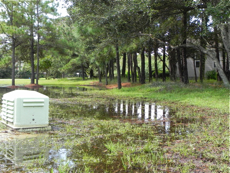Reprinted from the Outer Banks Voice
NAGS HEAD — A 50-year-old network of ditches, culverts and pipes in Nags Head dramatically showed its age after more than 3 feet of rain this spring and summer.
Town Manager Cliff Ogburn has identified as many as two dozen spots around town where rain and runoff inundated a stormwater drainage system that dates back to the Ash Wednesday Storm of 1962.
Supporter Spotlight
Downpours from Tropical Storm Beryl contributed to as much as 10 inches of rain in May. Then a stubborn weather pattern settled in, generating heavy showers and thunderstorms for the next three months. Some streets and neighborhoods saw flooding for most of the summer.
The state Department of Transportation has cleared some ditches along the bypass, but more work needs to be done, Ogburn said.
 Water from heavy rains all summer formed small ponds all over Nags Head. Photo: Outer Banks Voice |
Ogburn plans to come back to the Dare County Board of Commissioners with specific plans and priorities as well as cost estimates. But he added at a board meeting last week that any improvements cannot practically handle a once in 100-year or 500-year storm.
“We can build for a 10-year storm or a 25-year storm, but at some point the projects, no matter how well they’re engineered, are going to become overwhelmed,” he said.
Still, several problems areas need immediate fixes. Efforts to minimize flooding in Nags Head Acres and neighboring Vista Colony, for example, have been hampered by poor drainage along U.S. 158.
Supporter Spotlight
Runoff from the two neighborhoods is supposed to flow into a ditch, then under the bypass to an ocean outfall. But a difference of about 18 inches in the grade means the water collects on the west side of the bypass and eventually back into the neighborhoods.
Ogburn said that the hope is to channel some runoff south to another outfall, but state environmental rules and DOT regulations complicate efforts to move water.
Rainfall this year at Town Hall hit 36.87 inches through August. That is more than fell in 12 months every year since 2007 except 2010. That year, the measurement for the entire year was 38.03 inches.
So far this year, 50.37 inches have been recorded at 8th Street.
Town officials have surveyed several neighborhoods, cleaned out ditches and culverts and in some cases have pumped out water. They have met with the DOT and the National Park Service, which have jurisdiction over several ditches and canals.
The Department of Transportation has agreed to contribute $20,000 for a modeling study in South Nags Head. The town would have to cover any added costs.
East-west ditches on Park Service land, Ogburn said, can be returned to their original depths without an environmental impact statement. But an environmental assessment might be needed.
In others areas, lowering groundwater levels with pumps, a technique used in Kill Devil Hills, might provide a solution. But that will depend on where the water goes and if state environmental regulations will allow it.
Ogburn said the $4 stormwater fee assessed property owners raises only $150,000. He said the town will have to look at other sources of money for fixes throughout Nags Head.
“We’ve got to prioritize and spend the public dollar where it will do the most good,” said Mayor Bob Oakes.







